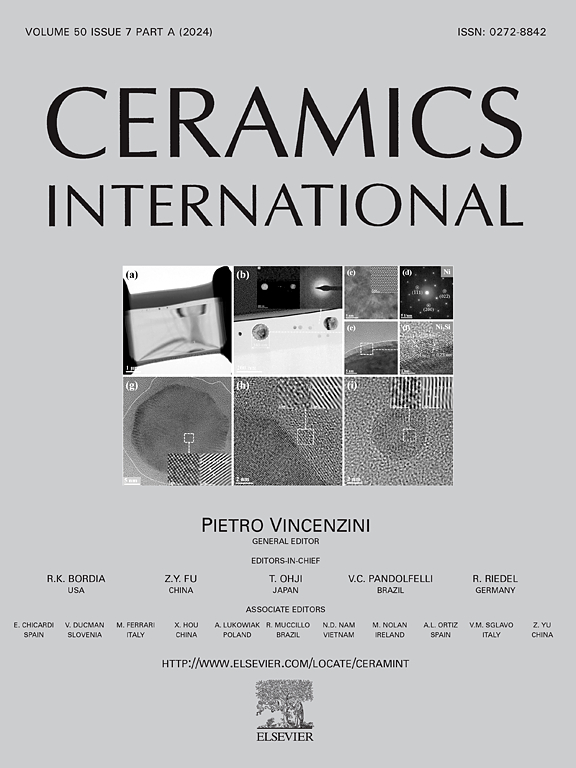New porous lithium metasilicate glass-ceramics prepared by cold sintering process associated with post-annealing technique
IF 5.6
2区 材料科学
Q1 MATERIALS SCIENCE, CERAMICS
引用次数: 0
Abstract
With the usage of gel-derived powders and NaOH solutions, porous lithium metasilicate (Li2SiO3, written as LM) glass-ceramics were prepared by cold sintering process (CSP) associated with post-annealing technique. With concentrations of NaOH solutions rising from 5 M to 20 M, an increasing degree of silicate structure depolymerization and more Si–OH groups were found for cold sintered pellets, and subsequently upward trends in number and size of spherical pores appeared for resultant porous glass-ceramics. Its total porosity and average size of formed spherical pore varied from 27.7 ± 2.2 % to 55.8 ± 1.8 % and 2.40 ± 1.17 μm to 14.99 ± 11.27 μm. In the meanwhile, precipitated crystals in pore walls exhibited rising volume fractions and gradually evolved from lithium disilicate (Li2Si2O5, written as LD) phase to LM phase with concentrations of NaOH solutions increasing. Young's modulus and hardness of pore walls for resultant porous glass-ceramics rose from 14.8 ± 3.1 GPa and 0.9 ± 0.2 GPa to 78.8 ± 3.8 GPa and 7.3 ± 0.7 GPa, along with its flexural strengths increasing from 17.3 ± 1.3 MPa to 56.1 ± 1.2 MPa. The proper mechanical properties made resultant porous LM glass-ceramics to be a promising candidate in preparing hybrid dental composites: polymer-infiltrated-ceramic-network (PICN) materials.
采用冷烧结结合后退火技术制备新型多孔偏硅酸锂微晶玻璃
利用凝胶粉末和NaOH溶液,采用冷烧结结合后退火技术制备了多孔偏硅酸锂(Li2SiO3, LM)微晶玻璃。随着NaOH溶液浓度从5 M增加到20 M,冷烧结球团的硅酸盐结构解聚程度增加,Si-OH基团增多,由此产生的多孔微晶玻璃的球形孔数量和大小呈上升趋势。总孔隙度为27.7±2.2% ~ 55.8±1.8%,形成的球形孔平均孔径为2.40±1.17 μm ~ 14.99±11.27 μm。同时,随着NaOH溶液浓度的增加,孔壁上的沉淀晶体体积分数逐渐上升,并逐渐由二硅酸锂(Li2Si2O5,写为LD)相向LM相演化。所得多孔微晶玻璃的杨氏模量和孔壁硬度分别从14.8±3.1 GPa和0.9±0.2 GPa提高到78.8±3.8 GPa和7.3±0.7 GPa,抗弯强度从17.3±1.3 MPa提高到56.1±1.2 MPa。所制备的多孔LM微晶玻璃具有良好的力学性能,是制备杂化牙科复合材料——聚合物渗透陶瓷网络(PICN)材料的理想选择。
本文章由计算机程序翻译,如有差异,请以英文原文为准。
求助全文
约1分钟内获得全文
求助全文
来源期刊

Ceramics International
工程技术-材料科学:硅酸盐
CiteScore
9.40
自引率
15.40%
发文量
4558
审稿时长
25 days
期刊介绍:
Ceramics International covers the science of advanced ceramic materials. The journal encourages contributions that demonstrate how an understanding of the basic chemical and physical phenomena may direct materials design and stimulate ideas for new or improved processing techniques, in order to obtain materials with desired structural features and properties.
Ceramics International covers oxide and non-oxide ceramics, functional glasses, glass ceramics, amorphous inorganic non-metallic materials (and their combinations with metal and organic materials), in the form of particulates, dense or porous bodies, thin/thick films and laminated, graded and composite structures. Process related topics such as ceramic-ceramic joints or joining ceramics with dissimilar materials, as well as surface finishing and conditioning are also covered. Besides traditional processing techniques, manufacturing routes of interest include innovative procedures benefiting from externally applied stresses, electromagnetic fields and energetic beams, as well as top-down and self-assembly nanotechnology approaches. In addition, the journal welcomes submissions on bio-inspired and bio-enabled materials designs, experimentally validated multi scale modelling and simulation for materials design, and the use of the most advanced chemical and physical characterization techniques of structure, properties and behaviour.
Technologically relevant low-dimensional systems are a particular focus of Ceramics International. These include 0, 1 and 2-D nanomaterials (also covering CNTs, graphene and related materials, and diamond-like carbons), their nanocomposites, as well as nano-hybrids and hierarchical multifunctional nanostructures that might integrate molecular, biological and electronic components.
 求助内容:
求助内容: 应助结果提醒方式:
应助结果提醒方式:


